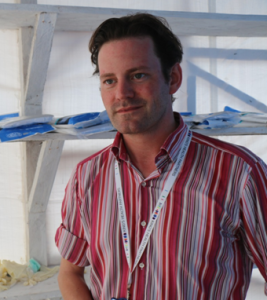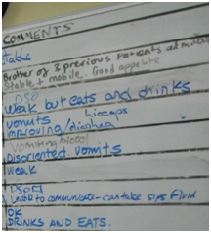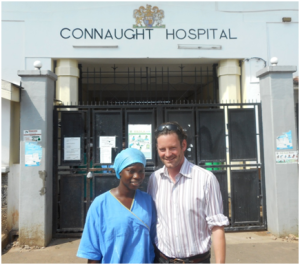 In the second instalment of this blog series, I will share some ongoing challenges faced by Sierra Leone in treating Ebola Virus Disease (EVD). I will also share some success stories and how both will help shape the future of healthcare in the region.
In the second instalment of this blog series, I will share some ongoing challenges faced by Sierra Leone in treating Ebola Virus Disease (EVD). I will also share some success stories and how both will help shape the future of healthcare in the region.
Challenges
This week I watched several people die in front of me, helpless to do anything. As health professionals, this is not what we are trained for. We assess. We diagnose. We treat. One young man was being cared for in an isolation unit, waiting for his test result to come back. It had been two days since it was sent and a result was expected later that day. It would be too late. A fit, young, muscular man, he was propped upright by his younger brother—also suspected of having EVD. His breathing was laboured, his eyes vacant, his body limp. He died in his brother’s arms a minute later.
With high turnaround, and a mixture of suspect cases and known positive patients awaiting transfer, there are limitations in the care that can be safely provided. Aggressive intravenous hydration has its dangers and cannot be safely provided to all. Despite a physical separation of patients to prevent cross contamination, lines come out and blood can be exposed to other patients in adjacent beds. Getting to a dedicated treatment centre provides the best chance of survival.
Some of the symptoms seen in patients in our isolation unit.
One older lady awaited a bed in a triage area outside a centre for testing. The unit was full. There was no safe way to provide care outside. She died there with her family, having presented for the care that could not come.
Both deaths highlight the system challenges we face and the bottlenecks that exist. We need newly opening facilities to scale up their care. We need to know how many people are symptomatic in the community, how long they wait before presenting for care, and why and where they are infected. We need to know how long it takes for a bed to become available, for a test to be sent, for a treatment unit to accept them. We need this in real time, by facility and region. We are working to streamline the existing data sources into a readily available format where this can be assessed each day, so that we can best direct valuable resources and prevent more tragic deaths.
Successes
As more people become infected with EVD, despite the mounting death toll, there are also increasing numbers of patients walking out of centres disease free. One such survivor is Belkisu. Admitted into our unit after her fever developed in another facility, she was cared for, survived, and discharged.
Now she is back in Connaught Hospital: not as a patient, but as a care provider. As a nurse fighting to help those facing a similar situation to pull through, she can not only provide the medical care so vital to those who cannot care for themselves, and whose family and friends cannot do so safely. She can also help people through their fears and frustrations. There are more like her. They provide hope that people can be cured—hope that with good care, all is not lost once infected. And they exemplify the resilience of a people that have lived through war and poverty, only to find a greater challenge ahead.
Belkisu, a nurse treated and discharged in our unit, who bravely returned to work to care for others.
As well as Belkisu, there are other successes. Community engagement is working. People are presenting for care, and we must work to bring it to them. The healthcare workers I meet are not scared. They are angry at the disease that has robbed them of their colleagues, their family, and their friends. They are resolved to fight this, but they need support and we must help them. Technical, clinical, and logistical expertise are being deployed and, as beds are built, hope for the future increases. But we must continue to push forward relentlessly. Complacency feeds this epidemic.
Looking forward
EVD can be controlled. Every previous outbreak has been contained and, though more challenging, this outbreak is no exception. The public health benchmarks of disease control are being rolled out. We hopefully will see a decline in numbers. But efforts must not stop. Smaller, more localised outbreaks may re-emerge. For the foreseeable future, any patients with compatible symptoms will require testing, as the lack of local diagnostic capacity will hamper the ability to rule out EVD.
For countries where EVD is endemic, such as the Democratic Republic of Congo, sporadic re-entry of the virus into the local population is an ongoing concern. Capacity must remain to isolate, test, and treat EVD. This must be responsive, scalable, and adaptive to the local epidemiology.
The King’s Sierra Leone Partnership model of care is one option to help embed this capacity within the community. By integrating isolation units into existing healthcare facilities, by training local staff, and by providing regular supervision and troubleshooting, we aim to allow existing facilities to function as EVD testing and referral sites. These facilities also provide the other arms of healthcare so needed in the region: paediatric vaccination programmes, maternal and child health, HIV and tuberculosis treatment. It will allow for EVD care to be redeployed with trained, on site staff if and when the need should arise. It allows for the rest of the health system to rebuild alongside the threat of EVD. It is by no means the only model, but we feel it contributes to the response in a manner that can help—both today and tomorrow.
Colin Brown is infectious diseases lead, King’s Sierra Leone Partnership.
Competing interests: Nothing further to declare.


